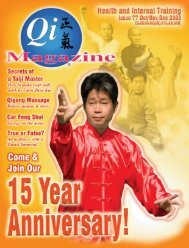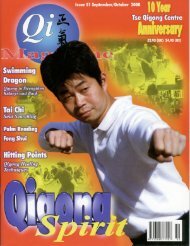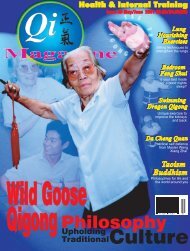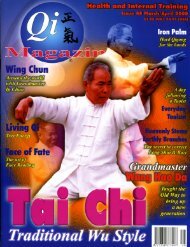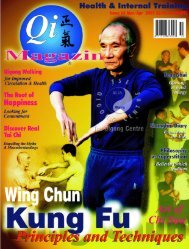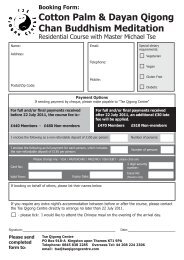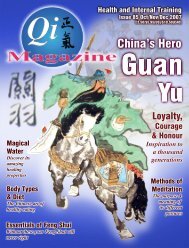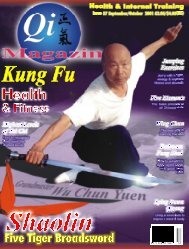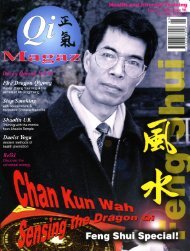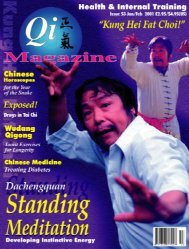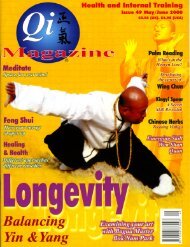Issue 65 - Tse Qigong Centre
Issue 65 - Tse Qigong Centre
Issue 65 - Tse Qigong Centre
- No tags were found...
You also want an ePaper? Increase the reach of your titles
YUMPU automatically turns print PDFs into web optimized ePapers that Google loves.
SouthFireEastWood<strong>Centre</strong>EarthWestMetalNorthWaterWhen we study Taijiquan, first we need tounderstand the principle of Yin and Yang, suchas soft and hard, solid and light, left and right.The next step we need to know is about theFive Elements and how they relate to Taijiquan.Five Elements relate to the footwork, which includes forward,backward, left, right and centre. These directions connect tothe Five Elements. Front is south and is fire element. Back isnorth and is water. Left is east and is wood. Right is west andis metal. <strong>Centre</strong> is earth and is your centre of gravity.Five Element theory is one of the high levelunderstandings of Taijiquan, particularly, when we apply it toTui Shou (Pushing Hands). For example, when you are doingTui Shou with your opponent and his energy is stronger thanyou, stepping back is the best solution. We cannot hold or goagainst an opponent’s energy. Otherwise you may be pushedaway or hurt. Stepping back can help us avoid their energybut also allow us to use their energy. On the other hand, ifyour opponent is weaker, then you can step forward to pushthem away or control them.Sometimes it will come to the situation when youropponent is strong but only on one side. For example, if hepushes you on your left side, then you can use your right sideto push him back. The more you practise, the more you willfind that Tui Shou is based on a lot of changing and being ableto feel where the energy is coming from.Sometimes you may come across a situation where theenergy is fifty-fifty on both sides and you will stand still, untilyour opponent changes his energy. If he does not move, youshould not move. If he does move, you move even faster inthe right direction. It is all based on listening to the energy.During Tui Shou, once you have touched hands withyour opponent, you should straightaway read his energy andrespond to that. If he is too strong, you should let go. If he isweak, go forward. If his left side is strong, go to his right side.If his right side is strong, go to his left side. If you don’t know,stay still. Practising Taijiquan is moving yourself like a ball. Theball can roll in any direction. It can turn clockwise or counterclockwise.Sometimes the ball will be very soft, like cotton.Sometimes it will be hard, like iron. Also, sometimes the ballwill change shape. It may be long, or it may be short. The ballis very flexible and changeable. It is all based on thecircumstance.No matter how the ball moves, the centre of gravityshould always remain at the centre. This means no matterwhat movement we do, our Dantian will maintain the centreto keep us balanced. Once our centre loses balance, then it isover. When you do Tui Shou with your opponent, you are tryingto find and dislodge their centre of gravity in order to makethem lose balance. A higher level Taiji master will be veryquick to find out his opponent’s centre of gravity with lesseffort. A low level Taiji master will use a lot of effort, but stillwill not be able to find their opponent’s centre of gravity.Therefore, sometimes you ask yourself how much effort youhave to use to find your opponent’s centre of gravity. Tounderstand the principle of Taijiquan, it will also help you tounderstand the problems of your lifeBy Michael <strong>Tse</strong>Qi Magazine Jan/Feb 2003 page 19



